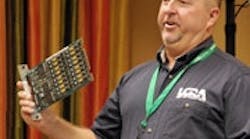"So far, our new control system has been in place for a year and a half. It's run untouched with no card failures and is also a more secure system." LCRA’s Scott Matus detailed the company’s use of EcoStruxure Foxboro migration cards to modernize an end-of-life system without disturbing much of the instrumentation wiring.
Process controls can run for decades without calling attention to themselves, but there comes a time when they must be replaced, and these brief times can remind everyone just how crucial they really are.
After more than 30 years managing the coal-fired, 450-MW unit at the Fayette Power Project (FPP) near LaGrange, Texas, the legacy Bailey NET 90 DCS, token-ring network and I/O cards were failing, causing outages and trips. The unit was built in 1986, and is part of FPP's three-unit, 1,720-MW facility, which is operated by the Lower Colorado River Authority (LCRA), which provides power from north-central Texas eastward to the Gulf of Mexico.
"We needed to upgrade and migrate all of our unit's controls, including production, safety, boiler, turbine and generation," said Scott Matus, I&C specialist, LCRA, who discussed the modernization project at this week’s Schneider Electric Innovation Days in Austin, Texas.
Motivated to migrate
Beyond its primary controls that were half-and-half legacy Bailey and Foxboro, the 450-MW unit's original design included GE Mark IIA turbines controls, Woodward BFPT speed controls, GE Series 6 PLCs for auxiliary controls, and a hard-panel control room-BTG board.
"There had been several previous failed attempts to upgrade either the Bailey or Foxboro system to one solution, including a proposed full-bulldoze upgrade to Foxboro," explained Matus. "We'd also added a lot of Foxboro I/A controls prior to the migration project, but we finally got to the point where it was less costly to migrate to all EcoStruxure Foxboro DCS than it was to keep using our old equipment. Our information security department also pushed to upgrade our HMIs and Server 3000 devices using Microsoft Windows XP to Windows 7."
Running for 10 months from June 2017 to April 2018, the unit's migration mainly included replacing the end-of-life I/O cards with EcoStruxure Foxboro 200 Series I/O migration cards and replacing the end-of-life controllers with EcoStruxure Foxboro FCP280 controllers.
Teams and databases
To approach and tackle the migration, Matus reported that LCRA and Schneider Electric assembled small teams to not only migrate the utility's controls, but also upgrade its power supplies and other support systems.
"There was also a big question about how to do our factory acceptance test (FAT) because even though we were migrating controllers and I/O cards, we were leaving all of the field wiring and loop cabling in place," added Matus. "We also took all our configuration drawings and put them into databases.”
The existing database descriptions of the Bailey system left over from past modernization attempts were reduced and revised. “We had a database of all cabinets with module layouts and jumper configurations of the module mounting units, plus a database of individual card jumpers and signal levels. We got a little paper happy with all the printouts we made about how to put everything together."
New controls emerge
Following database development and design of the unit's new control system, its main components now include:
- Windows 7, Server 2008 and Server 2012 with physical and virtual machines;
- EcoStruxure Foxboro DCS Control Core Services 9.3 and EcoStruxure Foxboro DCS Control Software Editor;
- Foxview HMI and Foxdraw 10.4.4 software;
- Controller and I/O layout with FCP/ZCP270s and FCP280s with 200 Series I/O migration cards;
- Mesh control network with SCN for virtual machines and DCN for domain;
- System Auditor software; and
- Security founded on role-based access to the control system via the DCN and centralized security management.
When the applicable team members undertook logic and operator display designs for the new control system, Matus reported there was a lot of available logic that they didn't need, so they pulled what wasn't necessary and were able to reuse designs on many of their 40 primary display screens from other applications. "We converted existing Bailey logic to EcoStruxure Foxboro logic and used Foxboro logic we had developed in the course of prior upgrade attempts," said Matus.
Preparation eases startup
During the FAT in Houston, LCRA and Schneider Electric teams performed migration module testing of individual cards, tested the logic and displays using loopback simulation, and tested the new system's overall setup and functions.
"All of our testing and preparations really helped when we got to migration day," added Matus. "We had one crew set up the EcoStruxure Foxboro system, another replace the power supplies, and a third install the migration cards. We also installed new cabinets for the networks, servers and controllers, then determinated and reterminated the wiring for our remote I/O cabinets from the former Bailey 800 I/O, and installed the new 200 Series I/O.
"The startup went very smoothly overall—it was almost like a regular startup," said Matus. "So far, the new control system has been in place for a year and a half. It's run untouched with no card failures and is also a more secure system."






